Sicily, the largest island in Italy and the Mediterranean Sea, is renowned for its rich history, stunning landscapes, and delicious cuisine. Influenced by numerous civilizations like the Greeks, Romans, Arabs, Normans, and Byzantines, its long and complex history has left a profound mark on the island’s architecture, culture, and cuisine. This blend of history and natural beauty, coupled with warm hospitality, makes it a captivating place to visit. In this blog post, we’ll share our Sicily East Coast Itinerary.
Our friends from Sicily invited us to their wedding in Taormina, providing the perfect opportunity to plan a Sicily East Coast itinerary and explore the island. This invitation was a privilege, allowing us to experience Sicily beyond its popular destinations and delve into its countryside while meeting local people. We’ll delve into these experiences later in the post, but for now, let’s dive into our Sicily East Coast itinerary.
Affiliate disclosure: This article contains affiliate links. If you choose to make a purchase through them, we may earn a small commission at no additional cost to you. These commissions help us continue creating helpful travel guides, tips, and inspiration. Thank you for your support!
Our Sicily East Coast Itinerary
Day 1: Catania
Giardini Bellini
Our trip started in Catania and we spent the day exploring the city. We started our visit at Giardini Bellini, a public park located in the heart of the city. This park is a peaceful oasis featuring lush green laws, well-maintained flower beds, and a wide variety of trees, including palm trees, cypress trees, and other Mediterranean flora.
Piazza Stesicoro
After relaxing at the park, we made our way to Piazza Stesicoro, renowned for its Baroque and Neoclassical buildings. Nearby lies the vibrant daily market “Fera ‘o Luni,” offering a wide variety of goods such as fresh fruits and vegetables, local products, and clothing. It’s an excellent opportunity to immerse yourself in the lively atmosphere of a traditional Sicilian market. However, the highlight of Piazza Stesicoro is undoubtedly the ancient Roman Amphitheatre. This archaeological site is one of Italy’s best-preserved Roman amphitheaters, partly integrated into the modern cityscape.
From here, underground city tours are available. It’s advisable to book these tours in advance as they only operate with enough participants, although private tours may be arranged for an additional fee.
Unlike in Naples, we decided not to explore the undergrounds on this occasion.
Via dei Crociferi
Later, we made our way to Via dei Crociferi, renowned as one of the most picturesque streets in Catania. This charming street is celebrated for its magnificent Baroque architecture, adorned with numerous Baroque churches, palaces, and buildings. Each structure boasts intricate facades, decorative balconies, and ornate sculptures, making it a paradise for architecture enthusiasts. As we strolled along, we couldn’t resist stopping for a refreshing granita to beat the heat.
GRANITA: A MUST TRY
Granita is a popular dessert originating in Sicily, made of water, sugar, and flavoring. The mixture of ingredients is stirred and then frozen. While it’s freezing, the mixture gets periodically raked with a fork to create a granulating texture. Lemon, strawberry, pistachio, almond, and mulberry are among the wide variety of flavorings. Granita is a must-try, especially on a hot day, paired with a traditional sweet brioche bun.
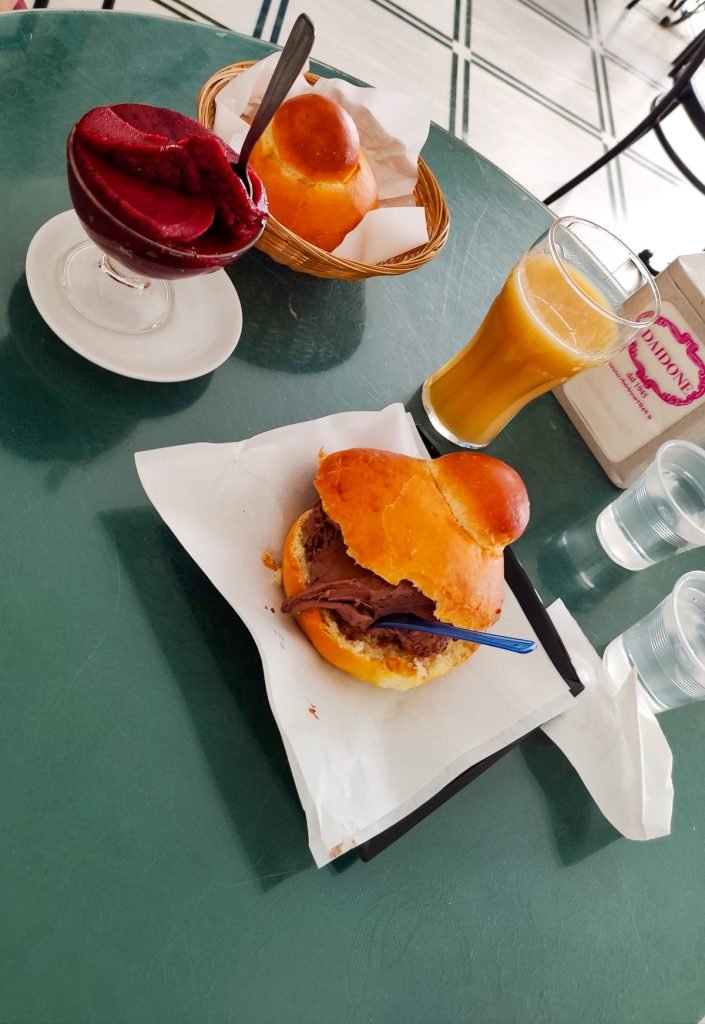
Fish Market
The fish market of Catania boasts a rich history dating back centuries, serving as a vital trading hub for fresh seafood in the region. Today, it remains a lively and bustling marketplace, offering a vibrant atmosphere for locals and visitors alike. We relished strolling through the market and indulging in a lunch of fresh fish. Open daily except on Sundays, from 8 am until early afternoon, it’s a must-visit destination for seafood enthusiasts.
Walking around the city centre
After lunch, we embarked on a leisurely stroll around the city center, beginning at Piazza Duomo, known for its historically significant buildings. The highlight of Piazza Duomo is Catania Cathedral, dedicated to the city’s patron Saint Agatha, which can be visited free of charge. At the heart of Piazza Duomo stands a striking statue of an elephant crafted from lava stone. This iconic fountain, known as “u Liotru” in Sicilian dialect, serves as the symbol of Catania.
Following a delightful sweet treat in Piazza Università, we proceeded to explore Badia di Sant’Agata, an 18th-century church. Our journey then led us to Teatro Massimo Bellini, Catania’s historic opera house, and Castello Ursino, a 13th-century castle housing the civic museum.
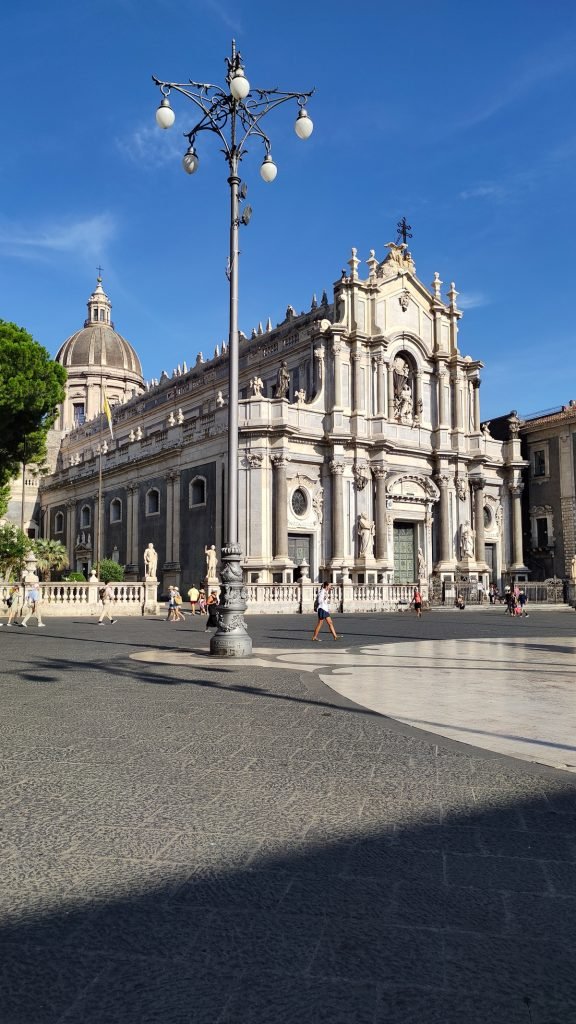
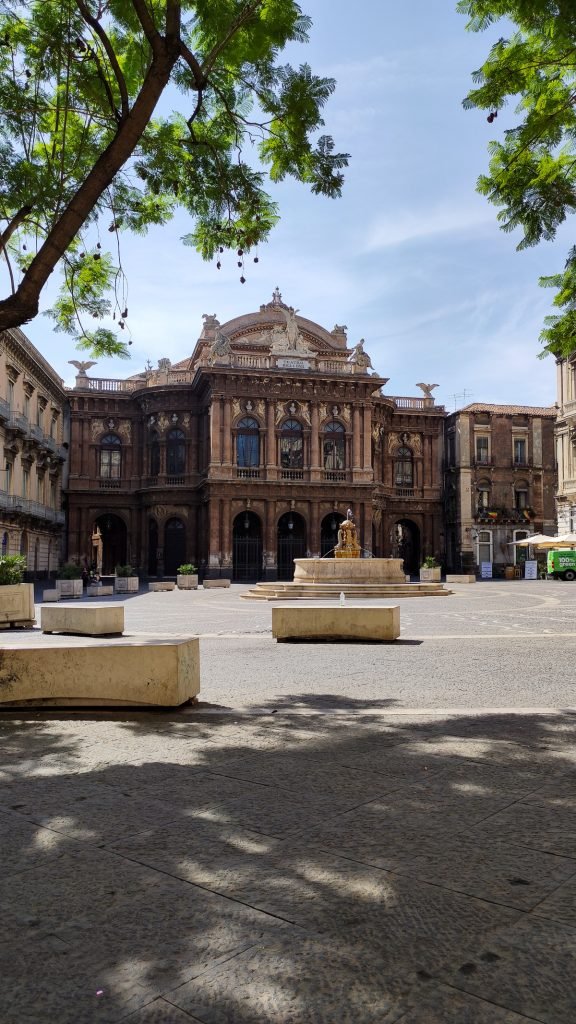
An off-the-beaten-track experience
Our day in Catania concluded with a visit to our friends’ village, Catenanuova. Here, we had the pleasure of meeting their family and friends and spending quality time with them. My friend’s dad owns a country house where he produces olive oil, surrounded by olive trees overlooking mountains and vast valleys. It was a remarkable experience listening to the locals’ stories and savoring delicious food amidst the stunning countryside backdrop. The locals were incredibly welcoming and friendly, making the experience even more memorable. If you ever have the opportunity to partake in a similar experience, don’t hesitate—just go for it!
Discover the best things to do in Catania
Day 2: Isola Bella
The wedding day was the highlight of the trip, hands down. We banqueted in front of Isola Bella near Taormina. The atmosphere and location were simply unbelievable, and we spent some quality time there.
The day after the wedding, we relaxed at the beach and swam in the crystal-clear waters of Isola Bella.
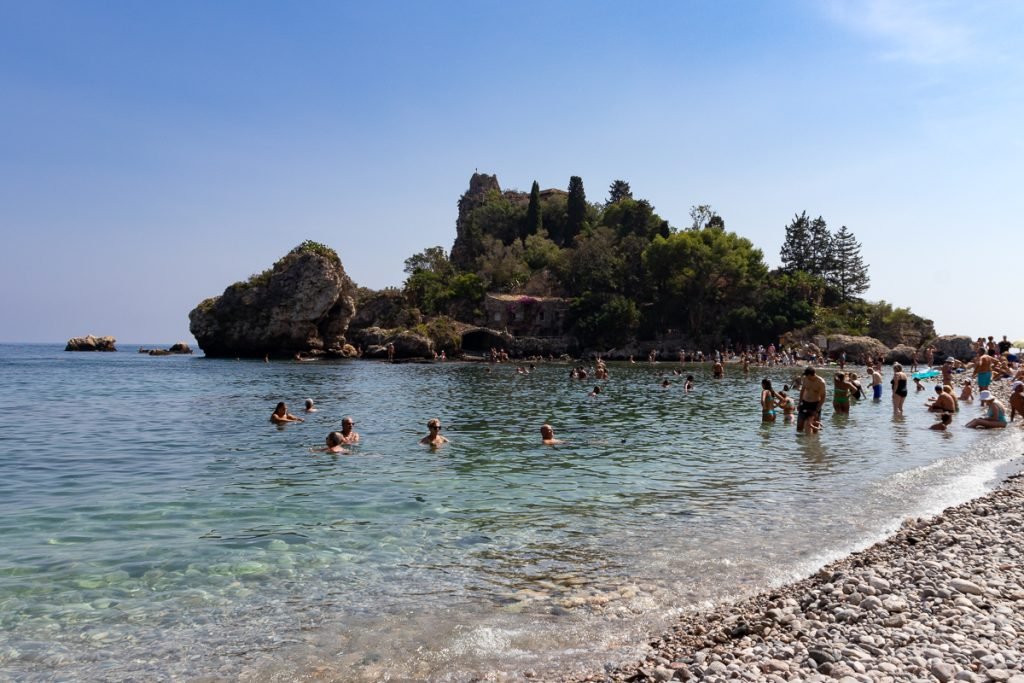
Isola Bella, also known as the “Beautiful Island,” is a small island located in the Ionian Sea. Part of a natural reserve, it features lush Mediterranean vegetation and is accessible via a narrow strip of land connecting it to the mainland. Visitors can enjoy all parts of the beach near the island for free and access the island itself for a small fee.
As part of your Sicily east coast itinerary, you can easily reach Isola Bella from Taormina by walking down the stairs from the Belvedere. This 20-minute downhill walk is fairly easy. However, returning to Taormina on foot from Isola Bella can be quite tiring. It is advisable to take a shuttle bus or a cableway instead.
Are you enjoying this blog post? Follow us to see the latest updates
Day 3: Taormina
Taormina is unquestionably a must-visit destination on any Sicily East Coast itinerary, renowned for its breathtaking Mediterranean vistas, rich historical sites, and vibrant atmosphere.
Our exploration began with a visit to the Greek Theatre, one of Taormina’s most iconic landmarks. Dating back to the 3rd century BC, this ancient theater offers panoramic vistas of Mount Etna and the coastline. Remarkably, the theater remains in use today for performances and concerts, adding to its allure as a unique cultural venue.
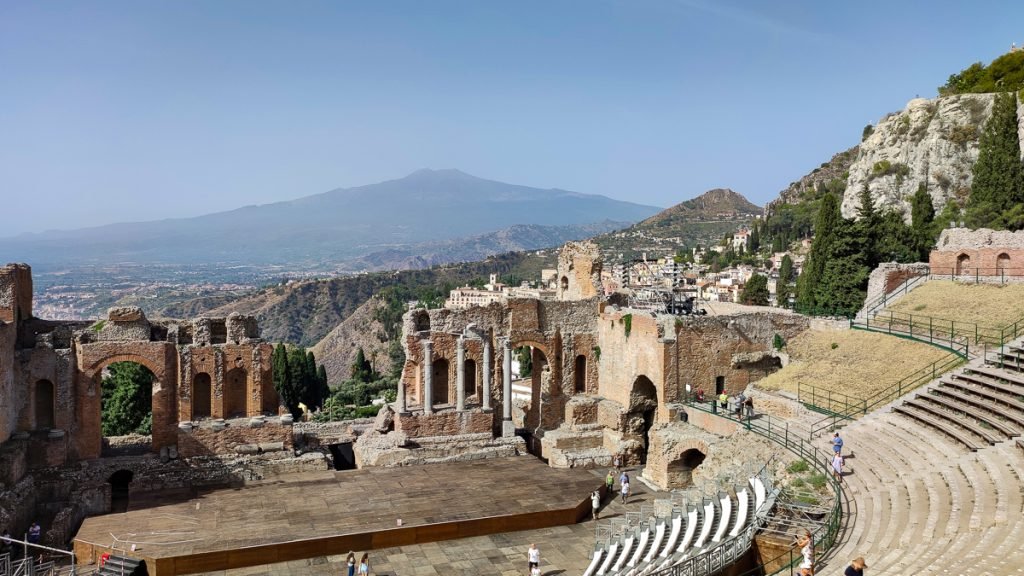
Next, we ascended to visit Chiesa della Madonna della Rocca. Perched atop a hill, this church boasts stunning panoramic viewpoints. Accessible via a lengthy stairway from the town below, the ascent can be quite strenuous, particularly in hot weather. We recommend avoiding the climb during peak temperatures.
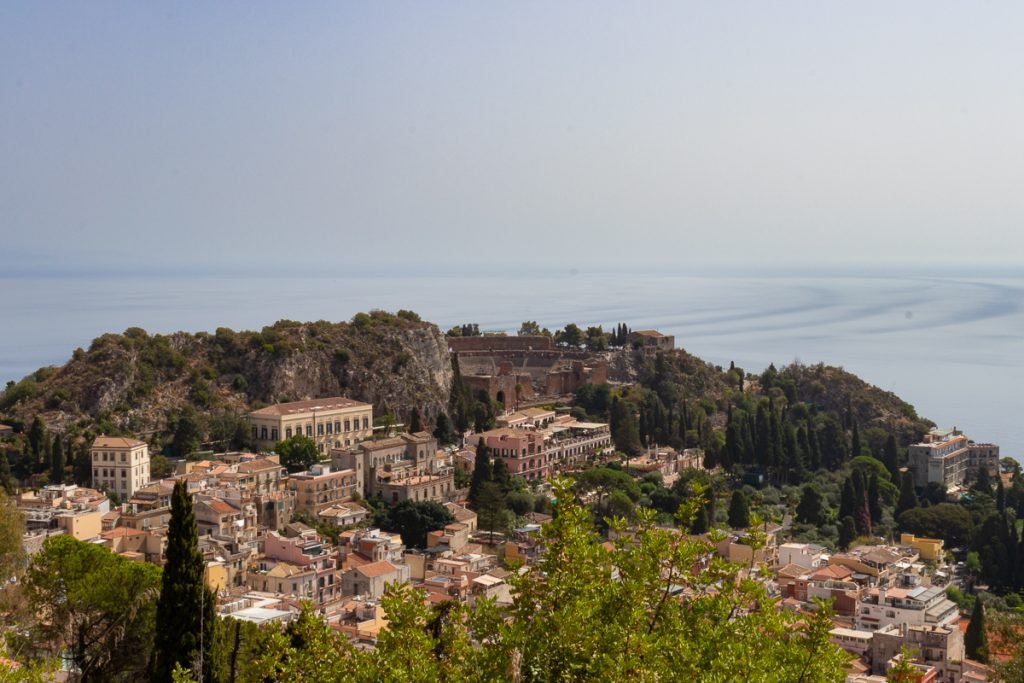
We were quite tired after that walk so we decided to get some Arancini.
ARANCINI: A MUST TRY
Arancini is a popular Sicilian street food item that has gained popularity throughout Italy and in many parts of the world. It is a deep-fried rice ball typically filled with various delicious ingredients such as ragu, butter, eggplants, or pistachio. There are multiple variations of arancini and each one has a wonderful combination of flavors and textures.
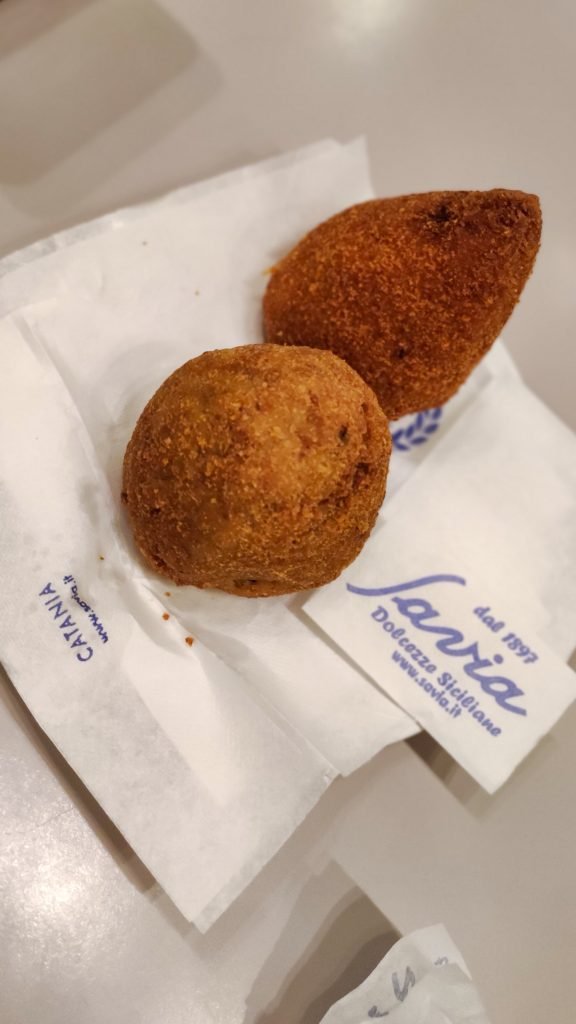
Villa Comunale and City Centre
We indulged in arancini at Villa Comunale, Taormina’s public gardens, a serene oasis adorned with vibrant flowers and lush greenery, offering breathtaking vistas of the sea and Mount Etna.
After unwinding for a while, we strolled along Corso Umberto I, Taormina’s bustling main street, and explored Piazza IX Aprile, a charming square boasting panoramic views of Mount Etna and the coastline. Wandering through the city’s palazzos and narrow alleys, we immersed ourselves in its unique atmosphere. As the day drew to a close, we boarded a bus back to Catania, where we spent the night.
GOOD TO KNOW!
For those planning to spend a few days in Taormina, exploring the myriad activities available is a must. Check out the best things to do in Taormina for an unforgettable experience.
Our Sicily East Coast Itinerary
Day 4: Mount Etna
As nature lovers and adventure seekers, we couldn’t resist visiting Mount Etna, Europe’s highest and most active volcano. With numerous Etna tours available, such as the popular the popular Etna Sunset Jeep Tour, we chose the Etna Summit Tour for an up-close experience. Most tours, including ours, offer lunch and vary in price depending on the altitude you wish to reach. Opting for the summit meant additional costs, particularly for the cableway, which alone amounted to approximately 50€ per person.
Our Mount Etna Tour
Our tour began early in the morning, starting with a cableway ascent and a brief jeep ride to 2900 meters. There, we met our alpine guide, who provided fascinating insights into the volcano’s various eruptions and rock formations. With incredible views and the summit craters emitting smoke behind us, the experience was truly unforgettable.
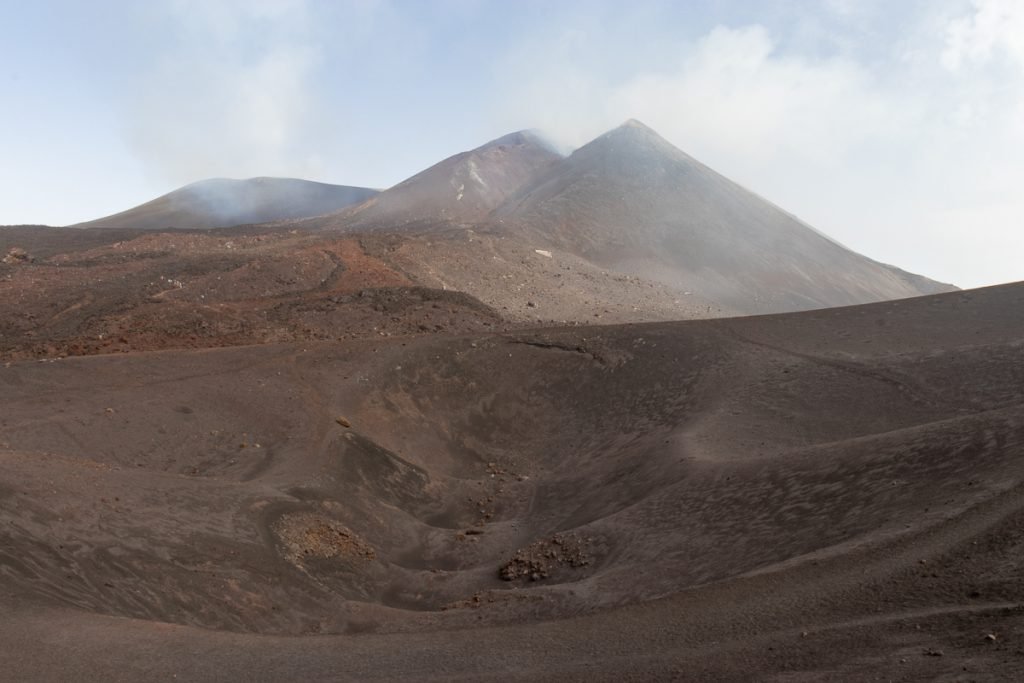
Afterwards, we descended for a quick lunch before embarking on a walk up the Crateri Silvestri, a pair of smaller craters easily accessible to visitors. Here, the colors of the rocks and minerals within the craters can vary, influenced by the presence of volcanic gases. Our tour concluded with a visit to a small cave formed from solidified lava.
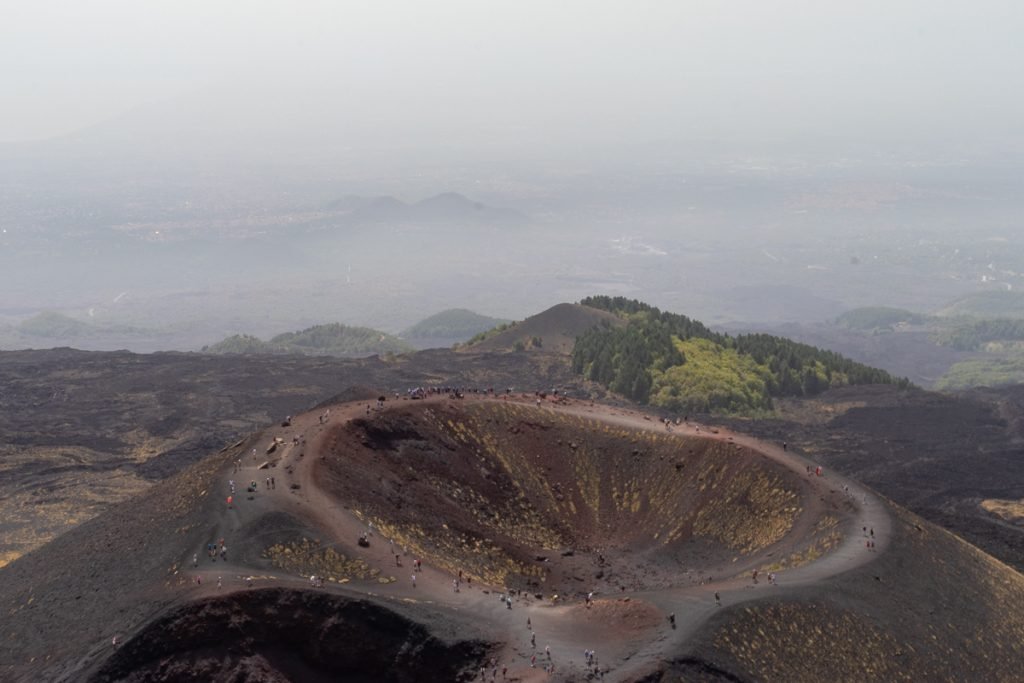
Mount Etna is an extraordinary natural attraction that should be a highlight of your Sicily East Coast itinerary. Not only is the volcano itself impressive, but the surrounding landscape is also incredibly beautiful.
In the evening, we indulged in some arancini at “Savia’s”. Renowned as one of the top producers of arancini in Catania, this café lived up to its reputation: their arancini were absolutely delicious!
GOOD TO KNOW!
If you’re interested in learning more about volcanoes in Sicily, check out the Stromboli blog from Off the Beaten Travel. This website is particularly useful for exploring hidden gems around the world.
Day 5: Aci Trezza and Aci Castello
On day 5, we explored two villages near Catania: Aci Trezza and Castello.
Our morning began with a delightful stop at “Luigi Ficarra’s” pastry shop, renowned for its freshly made cannolis and other homemade pastries.
GOOD TO KNOW!
In Sicily, pastry shops are a popular choice for breakfast. Locals often start their day at these establishments, enjoying homemade cakes or granita with brioche, accompanied by espresso or freshly squeezed orange juice.
Aci Trezza: a Lovely Fishing Village
Aci Trezza, a small village steeped in fishing tradition, is nestled against a backdrop of rugged cliffs. Along its coastline are the famed Cyclops Islands, locally referred to as “Faraglioni,” composed of volcanic rock formations. These dramatic structures contribute to the village’s unique and captivating coastal landscape. Legend has it that they were hurled into the sea by the one-eyed giant Polyphemus in Homer’s epic “The Odyssey.”
We took a leisurely stroll along the stunning coastline and took a refreshing swim before indulging in lunch at a local fish restaurant. Seafood dishes are a highlight in Aci Trezza, and we savored traditional linguine with squid ink and spaghetti with sea urchin.
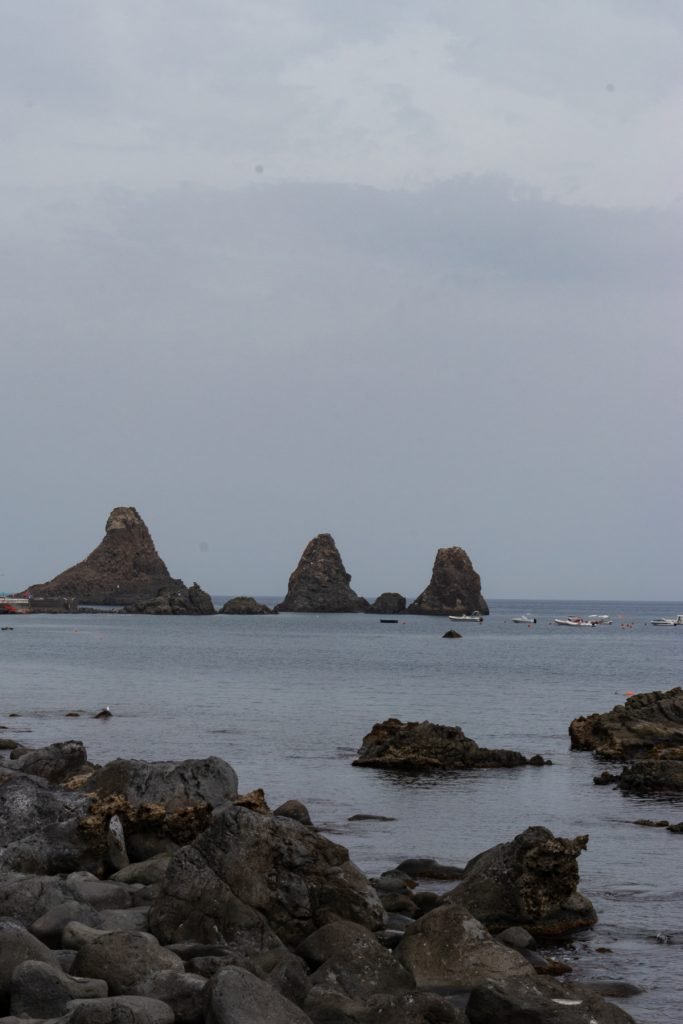
Aci Castello: a Charming Coastal Town
A mere 20-minute walk from Aci Trezza, we arrived in Aci Castello. The village’s most prominent attraction is the Norman Castle, situated atop a rocky promontory overlooking the sea. Dating back to the 11th century, this ancient fortress was constructed as a defensive stronghold against pirate raids. Today, it stands as a historic site open for exploration, providing visitors with panoramic views of the coastline and the sea, including the Faraglioni rock formations.
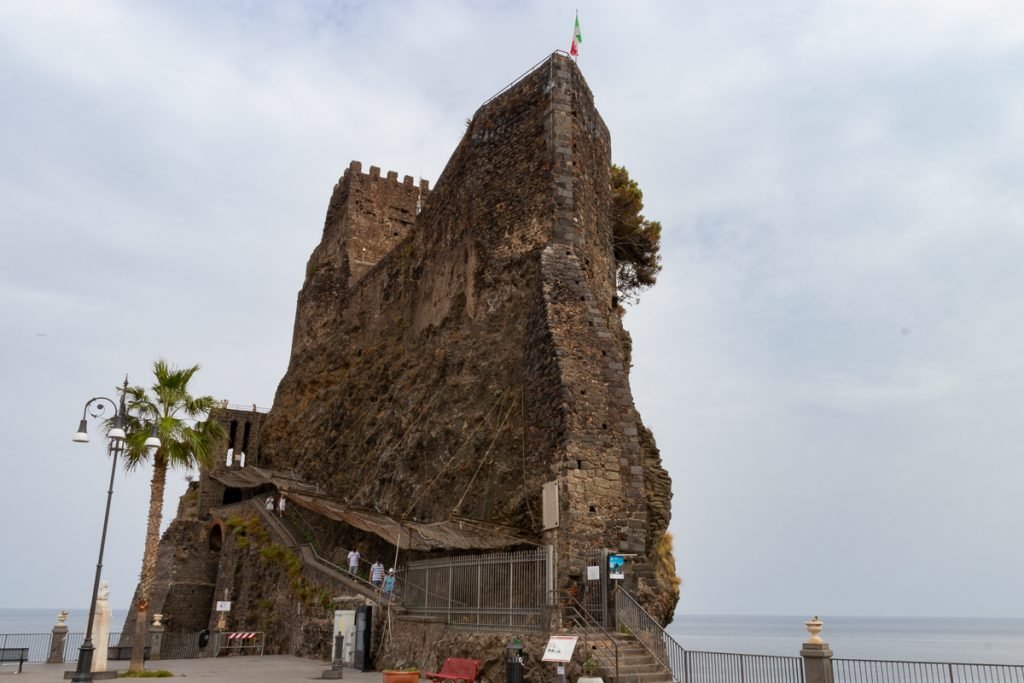
Day 6: Siracusa
On day 6, we embarked on an early bus journey to Syracuse. Upon arrival, we settled into our accommodation, La Casa di Aneupe. We were particularly drawn to this place for its finely decorated sea settings and the extremely welcoming hosts. Moreover, its convenient location within walking distance of Ortigia, Syracuse’s old town, added to its appeal.
Neapolis Archaeological Park
Afterward, we explored the Neapolis Archaeological Park, which houses well-preserved ruins from various historical periods, including ancient Greek and Roman times. Syracuse, once a powerful city-state in ancient Greece, boasts a rich cultural and historical heritage that is best experienced through a guided tour of the park.
A standout attraction within the park is the ancient Greek Theater of Syracuse, one of the world’s largest and best-preserved Greek theaters. Originally constructed in the 5th century BC, it has hosted various performances over the centuries and remains in use today! Additionally, the park features a Roman Amphitheater, where gladiatorial games and public entertainment were once held.
Another intriguing feature is the “Ear of Dionysius,” a captivating cave named after the tyrant Dionysius, who allegedly used its unique acoustics to eavesdrop on prisoners. Approximately 65 meters long, the cave boasts an impressive echo effect, adding to its mystique.
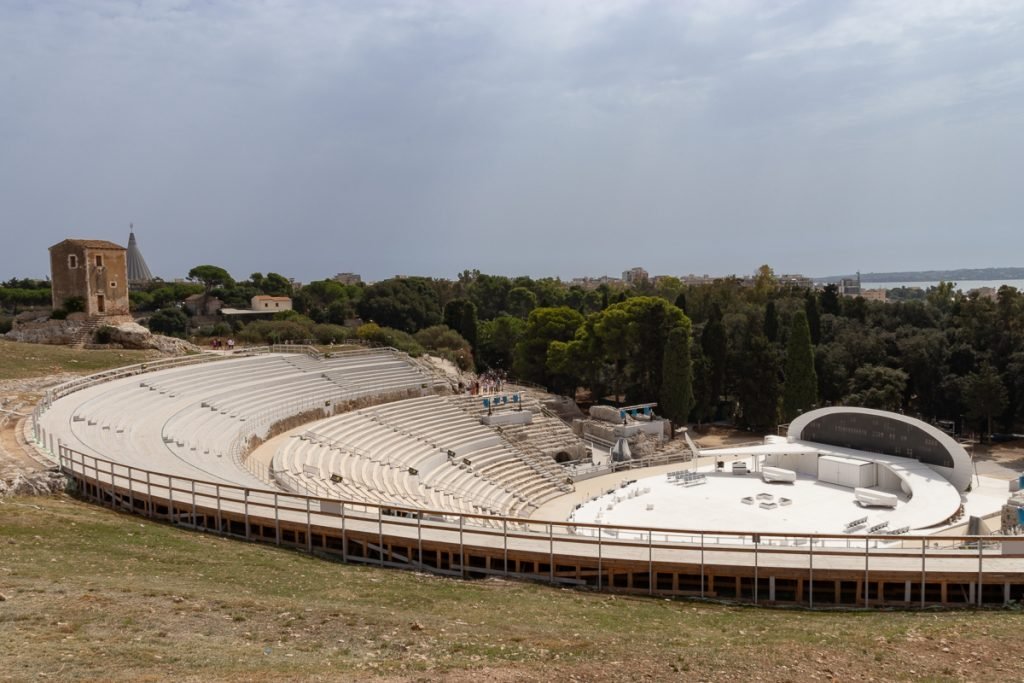
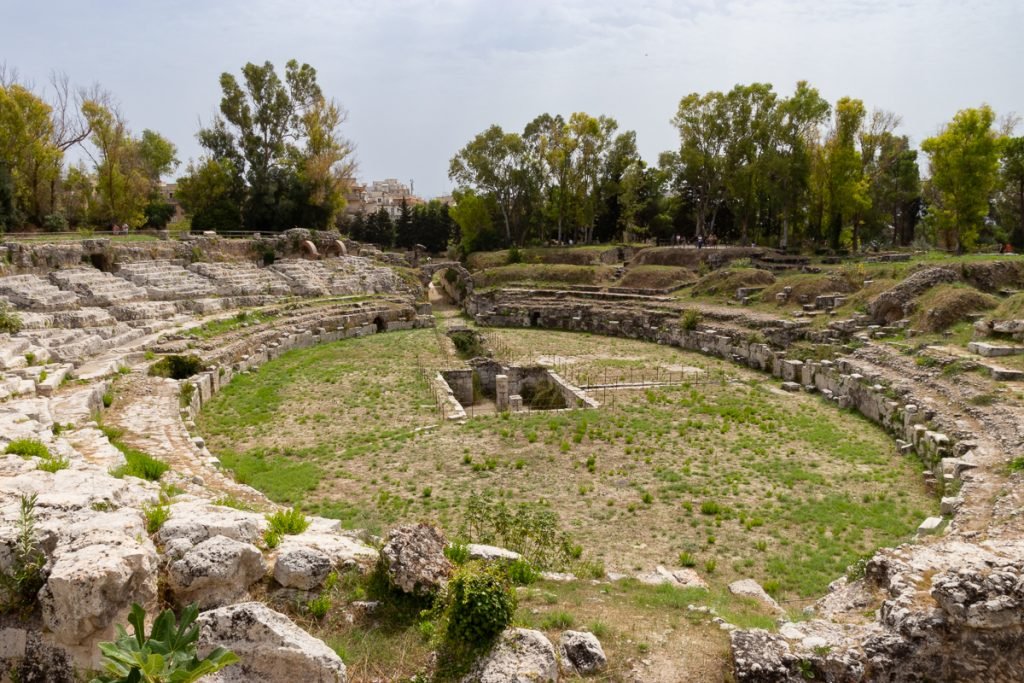
Ortigia
The rest of the day was dedicated to exploring Ortigia, the historic island adjacent to Syracuse. Renowned for its well-preserved Baroque architecture, narrow cobblestone streets, and historic buildings, Ortigia offers a glimpse into Sicily’s rich past. Highlights include the Cathedral in Piazza del Duomo, showcasing exquisite Baroque design.
We also visited The Fountain of Arethusa, a natural spring steeped in Greek mythology, and Castello Maniace, a medieval fortress offering panoramic views of Ortigia and the coastline.
Ortigia’s compact size and pedestrian-friendly layout make it ideal for leisurely exploration, ensuring a memorable experience amidst its charming atmosphere and historical landmarks.
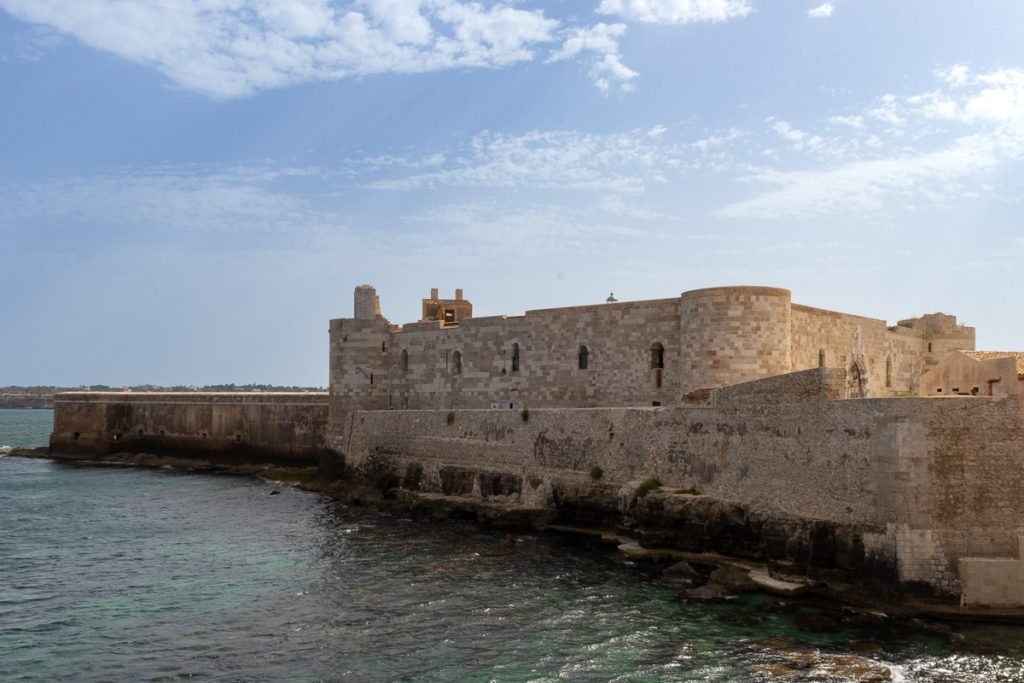
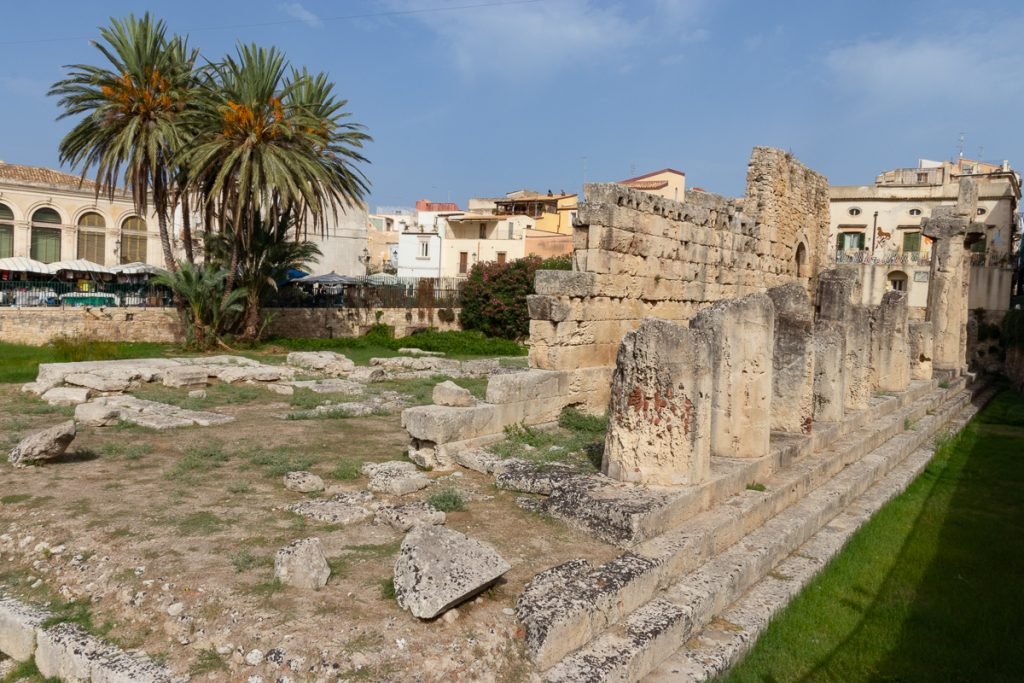
Day 7: Siracusa Fontane Bianche
Day 7 began on a sweet note with a delightful breakfast featuring brioche with gelato, a quintessential Sicilian treat not to be missed during your trip to Sicily! This traditional sweet brioche bun, filled with your choice of gelato, is a perfect way to kickstart your day.
We spent the rest of the day unwinding at Fontane Bianche beach. Located just 15 minutes from Siracusa, Fontane Bianche is a popular resort beach known for its long stretch of fine white sandy shores. Unlike many other beaches on the east coast of Sicily, Fontane Bianche boasts crystal-clear waters and is equipped with amenities such as umbrellas, sunbeds, restaurants, toilets, and lifeguards. We were fortunate to have great weather, allowing us to fully enjoy a day of relaxation, sunbathing, and swimming.

Our day concluded in Ortigia, where we were treated to a breathtaking sunset from a terrace overlooking the sea near the Fountain of Arethusa. Ortigia is renowned for its spectacular sunset views along its beautiful promenade, which offers unparalleled vistas of the coastline.
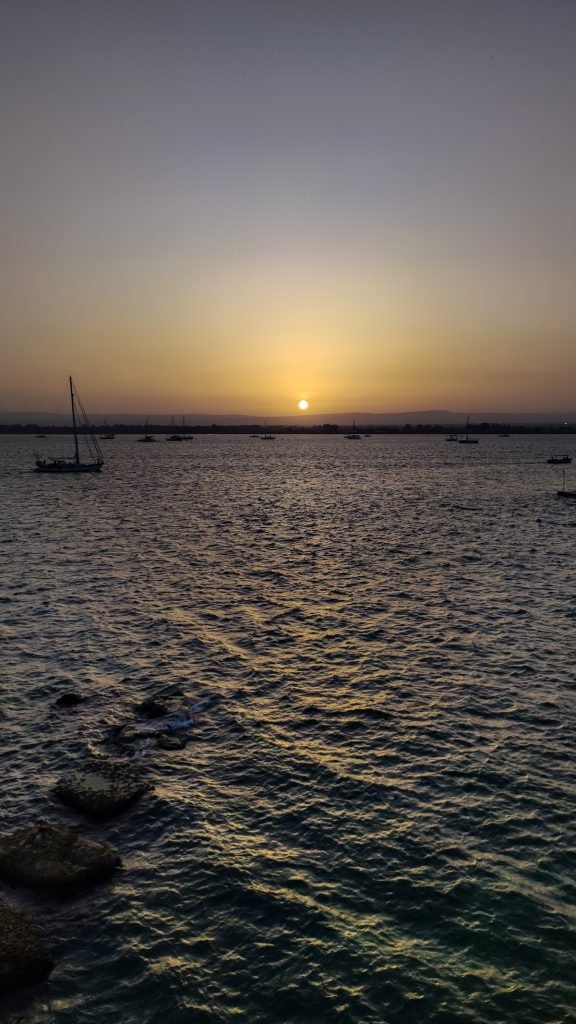
Day 8: Noto
On our final day, we ventured to Noto, renowned for its exquisite Baroque architecture, considered among the finest in Sicily. This picturesque town, not far from Syracuse, underwent a remarkable transformation after the earthquake of 1693, resulting in its entire reconstruction in the Baroque style. In 2002, Noto was rightfully recognized as a UNESCO World Heritage Site.
Exploring Noto was a delight as we wandered through its charming streets, marveling at the intricate facades, decorative elements, and splendid churches and palaces that adorn the town. One of the must-visit attractions is the Noto Cathedral, a grand church celebrated as a masterpiece of Sicilian Baroque architecture, adorned with impressive sculptures and decorations.
Palazzo Ducezio, serving as the town hall, is another notable example of Baroque architecture in Noto. Ascending the building offers a stunning view of the square and the town. Additionally, Via Nicolaci is not to be missed; this picturesque street is renowned for its Baroque buildings adorned with balconies featuring wrought-iron railings, intricate stucco work, and various mythological figures.
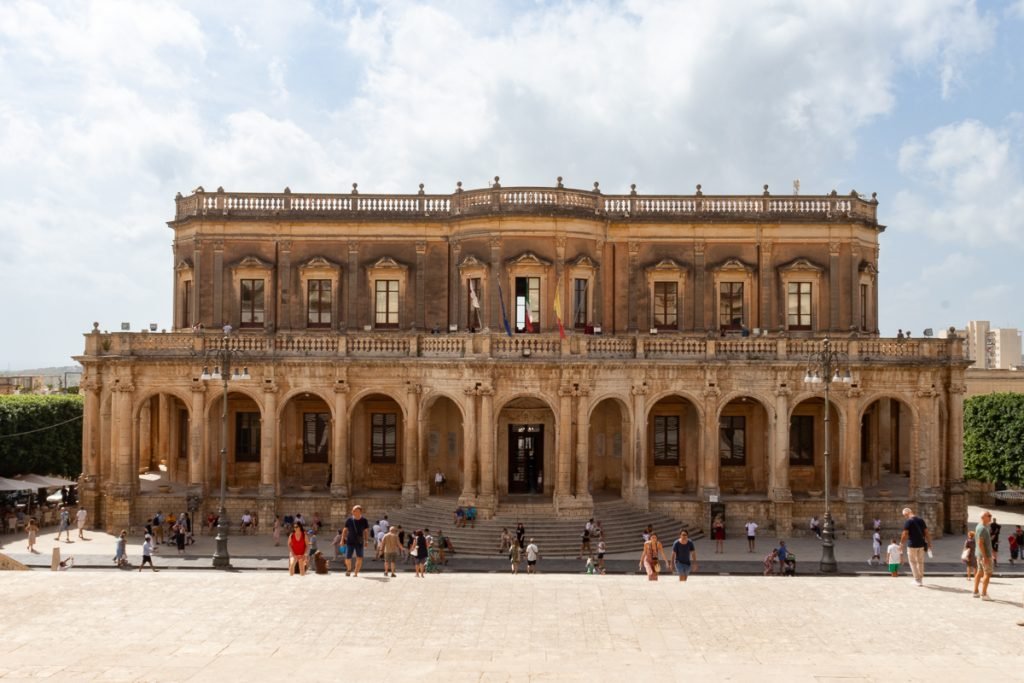

Our Sicily East Coast Itinerary: How we moved around
For our Sicily East Coast trip, we opted for public transport despite concerns about inefficiency. To our surprise, buses were punctual, affordable, and easy to navigate. Stations were clearly marked, and schedules were reliable. Having mobile internet made it much easier to check timetables and routes on the go. If you’re traveling from outside Europe, consider getting an Italian eSIM for seamless connectivity. Seeing Catania’s chaotic traffic and erratic driving only confirmed we made the right choice.
When exploring the Sicilian East Coast, we relied on these operators:
- We utilized Interbus, a major bus operator, for our intercity travels throughout Sicily. We recommend booking tickets in advance to avoid long queues at bus station ticket offices.
- For local transportation in Catania, we relied on Azienda Siciliana Trasporti (AST), the local bus operator. AST offered reliable service for our trips to Aci Trezza / Aci Castello, with tickets available for purchase at tobacco shops or newspaper stalls.
- When traveling to Fontane Bianche, we opted for Trenitalia, the national train operator in Italy. While our journey went smoothly, we suggest prioritizing Interbus over trains whenever possible. Tickets for Trenitalia can be purchased on their official website.
Sicily East Coast Itinerary
Time for Conclusions…
In this blog post, we shared our Sicily East Coast Itinerary which can be summarized as follows:
- Catania
- Isola Bella
- Taormina
- Etna Excursion
- Aci Trezza-Aci Castello
- Siracusa
- Fontane Bianche
- Noto
Our Sicily East Coast adventure was a perfect blend of city exploration, beach relaxation, and culinary delights. Sicily’s rich history, reflected in its baroque towns and ancient ruins, ensured there was never a dull moment. The local cuisine, especially the street food and pastries, surpassed our expectations and added to the overall experience.
Navigating Sicily with public transport proved to be reliable and convenient, particularly in cities like Catania where driving can be challenging due to overcrowded roads. The warmth and hospitality of the locals made our trip truly unforgettable, as they eagerly shared insider tips to enhance our experience.
While eight days provided a taste of Sicily’s treasures, there’s so much more to explore, especially along the West Coast. We’re already planning our return to uncover more of Sicily’s hidden gems.
Never leave home without travel insurance. Book now.
